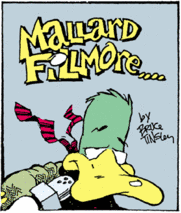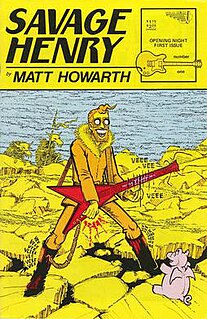
Robert Arthur Moog was an American engineer and pioneer of electronic music. He was the founder of Moog Music and the inventor of the first commercial synthesizer, the Moog synthesizer. This was followed by a more portable model, the Minimoog, described as the most famous and influential synthesizer in history.

An analogsynthesizer is a synthesizer that uses analog circuits and analog signals to generate sound electronically.

The Minimoog is an analog synthesizer first manufactured by Moog Music between 1970 and 1981.

The mallard is a dabbling duck that breeds throughout the temperate and subtropical Americas, Eurasia, and North Africa and has been introduced to New Zealand, Australia, Peru, Brazil, Uruguay, Argentina, Chile, Colombia, the Falkland Islands, and South Africa. This duck belongs to the subfamily Anatinae of the waterfowl family Anatidae. The male birds (drakes) have a glossy green head and are grey on their wings and belly, while the females have mainly brown-speckled plumage. Both sexes have an area of white-bordered black or iridescent blue feathers called a speculum on their wings; males especially tend to have blue speculum feathers. The mallard is 50–65 cm (20–26 in) long, of which the body makes up around two-thirds the length. The wingspan is 81–98 cm (32–39 in) and the bill is 4.4 to 6.1 cm long. It is often slightly heavier than most other dabbling ducks, weighing 0.72–1.58 kg (1.6–3.5 lb). Mallards live in wetlands, eat water plants and small animals, and are social animals preferring to congregate in groups or flocks of varying sizes. This species is the main ancestor of most breeds of domesticated ducks.

Moog synthesizer may refer to any number of analog synthesizers designed by Robert Moog or manufactured by Moog Music, and is commonly used as a generic term for older-generation analog music synthesizers. The Moog company pioneered the commercial manufacture of modular voltage-controlled analog synthesizer systems in the mid 1960s. The technological development that led to the creation of the Moog synthesizer was the invention of the transistor, which enabled researchers like Moog to build electronic music systems that were considerably smaller, cheaper and far more reliable than earlier vacuum tube-based systems.

ARP Instruments, Inc. was an American manufacturer of electronic musical instruments, founded by Alan Robert Pearlman in 1969. Best known for its line of synthesizers that emerged in the early 1970s, ARP closed its doors in 1981 due to financial difficulties. The company earned a reputation for producing excellent sounding, innovative instruments and was granted several patents for the technology it developed.

The VCS 3 is a portable analog synthesiser with a flexible semi-modular voice architecture, introduced by Electronic Music Studios (London) Limited (EMS) in 1969.

Trevor Colin Mallard is a New Zealand politician. He was formerly the Member of Parliament for the Hutt South electorate, and is currently a list MP and Speaker of the House. He was a Cabinet minister in the Fifth Labour Government of New Zealand holding portfolios including Environment, Labour, Broadcasting, State Owned Enterprises, Rugby World Cup and Education. He was also Associate Minister of Finance. In the 51st Parliament, he was the Labour Party spokesperson for Internal Affairs, and Sport and Recreation.

Barnstorm is the debut studio solo album by the American singer-songwriter and multi-instrumentalist Joe Walsh, following his departure from the James Gang. The album was released in October 1972 on the labels ABC and Dunhill. The core band on this album – Walsh, bassist Kenny Passarelli and drummer/multi-instrumentalist Joe Vitale – was also named Barnstorm. It was the first album to be recorded at Caribou Ranch in Colorado.
A mallard is a type of duck.

Moog modular synthesizers are modular synthesizers developed by the American electronic instrument pioneer Robert Moog. Many different models were manufactured by R.A. Moog Co. from 1965–80.

Mallard Fillmore is a comic strip written and illustrated by Bruce Tinsley that has been syndicated by King Features Syndicate since June 6, 1994. The strip follows the exploits of its title character, an anthropomorphic green-plumaged duck who works as a politically conservative reporter at fictional television station WFDR in Washington, D.C. Mallard's name is a pun on the name of the 13th president of the United States, Millard Fillmore.

Domestic ducks are ducks that are raised for meat, eggs and down. Many ducks are also kept for show, as pets, or for their ornamental value. Almost all varieties of domestic duck apart from the Muscovy duck are descended from the mallard.

Savage Henry is the title of a comic book series written and illustrated by Matt Howarth. The stories center on Savage Henry, lead guitarist of the "insect rock" band the Bulldaggers. Howarth regularly drew "guest appearances" by real world musicians in the comic book, including The Residents, Moby, Foetus, Hawkwind, Nash the Slash, and others.

"Stem" is a song by DJ Shadow from his 1996 debut studio album, Endtroducing...... The song reached number 9 on the Irish Singles Chart, DJ Shadow's only ever top 10 hit.

Gertie the Duck is an icon of Milwaukee, Wisconsin history and the subject of a 4-foot tall bronze sculpture by American artist Gwendolyn Gillen. It was installed on the Wisconsin Avenue bridge in September 1997.

















